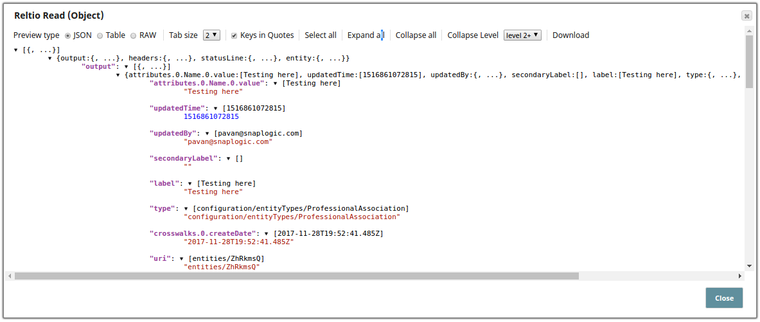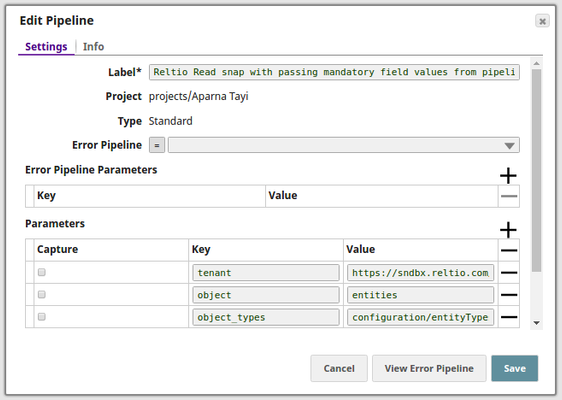| Snap type: | Read | ||||||
|---|---|---|---|---|---|---|---|
| Description: | This Snap reads the Reltio Objects (Entities only) from a specified Tenant. ETL Transformations & Data FlowThis Snap reads the Reltio data from the Reltio from the provided Object and Object Type. Input & Output
Modes
| ||||||
| Prerequisites: | A valid Reltio account with the tenant ID for the Tenant URL, or an API key for the Account Settings to be generated. An access from Reltio to merge the objects or entities The Reltio account must have sufficient access to read the objects from the Tenant. | ||||||
| Limitations and Known Issues: | None at this time. | ||||||
| Configurations: | Account & AccessThis Snap uses account references created on the Accounts page of SnapLogic Manager to handle access to this endpoint. See Reltio Account for information on setting up this type of account.of account. Views
| ||||||
| Troubleshooting: | |||||||
Settings | |||||||
Label | Required. The name for the Snap. You can modify this to be more specific, especially if you have more than one of the same Snap in your pipeline. | ||||||
| Tenant URL | Required. Specifies the Reltio host with Tenant ID. Use the this format, :
Example: https://sndbx.reltio.com/reltio/api/XK178mXYr3UZrG6/ Detault value: [None] | ||||||
| Object | Required. The Reltio Object to be created. This is a suggestible field. Reltio typically has four objects: entities
The suggestion works only when the valid account or the tenant URL is provided.
Default value: [None] | ||||||
| Batch size | Specifies the number of records to be processed in a single API call.
Default value: 50 | ||||||
| Thread limit | Required. Specifies the maximum number of threads for the Snap to create Reltio Objects.
Default value: 20 | ||||||
| Query parameters | Defines the query parameters and their values. The query parameters are attached to the URL using the http query parameter syntax, separated by '&' and are added as 'key=value' pairs. For example, when expression Expression is disabled, the Query Parameter 'max' with the key Value '5' displays the five records of the Object on the output preview. | ||||||
| Query parameter | Specifies the key used in the HTTP request for Reltio. Default value: [None] | ||||||
| Query parameter value | Specifies the key value for the particular Query parameter used. Default value: [None] | ||||||
| Group | This value indicates whether or not to nest the Nests multiple values of the same attributes. attribute by grouping them into a single tag. If not selected, then an attribute having with multiple values is displayed in two different tags else it will be grouped in a single tagseparate tags. Default value: Not selected | ||||||
| Retry limit | Determines the maximum number of attempts to retrieve the response. Since Reltio uses the exponential backoff , the retry mechanism applies policy only for HTTP Status Codes 502, 503 and 504 only and does not apply for the . Reltio has no retry policy for HTTP Status Codes 401, 403, 404, 500.
Default value: 5 Maximum value: 10 | ||||||
Basic
useUse Case
The following pipeline describes how the Snap functions as a standalone Snap in a pipeline:
Typical Snap Configurations
The key Snap Configurations configurations are:
With Expressions
- Query Query from Upstream
In the
- Snap settings shown below, the values are passed using an upstream Snap:
Pipeline Parameter
In the configuration shown below configuration, the values (Tenant URL, Object and Object types) are passed using the pipeline parameters:
The values as set in the Pipeline parameters:
Downloads
| Attachments | ||
|---|---|---|
|
| Insert excerpt | ||||||
|---|---|---|---|---|---|---|
|





